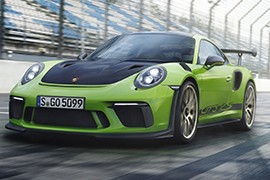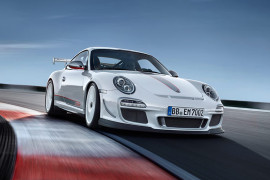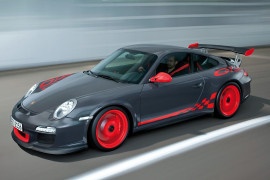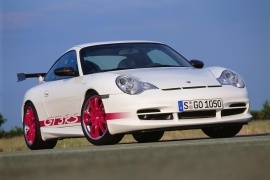PORSCHE 911 GT3 RS Models/Series Timeline, Specifications & Photos
First production year: 2004
Engines: Gasoline
Body style: Coupé (two-door)
While the rest of the 992 generation went for the turbocharged engines, the 911 GT3 RS had to stay naturally aspirated in order to get the FIA racing homologation for the GT3 class and is still based on the 991 generation.
The GT3 RS was designed for the race-track and with genuine motorsport solutions. It offered the aggressive look of a car that told you to stay out of its way. The round headlights offered the unmistakable Porsche 911 view. The big bumper with a low apron and grilles to cool the brakes and engine went low to the ground and an additional lip-spoiler amplified the downforce over the front axle. Due to engineering reasons, the front axle was fitted with 20” light-alloy wheels and 21” for the rear axle. The vents on the upper side of the front fenders relieved the air trapped in the wheel-wells. At the back, the big, adjustable, wing offered the much-needed downforce to help the car runs faster while cornering.
Inside, the race-inspired interior featured carbon-fiber bucket-seats, while the doors featured leather loops instead of door handles. The PCM (Porsche Communication Management) system was enhanced with a log feature that could have been downloaded and reviewed after the race. It showed braking points, race-lines, and accelerations (longitudinal and lateral). A no-cost option was the Clubsport package, which added a roll cage in the back a manual fire extinguisher, preparation for battery disconnect switch, and a six-point harness for track use. On top of that, the Weissach package added lighter magnesium wheels and additional carbon-fiber elements that lightened the car as low as 1430 kg.
The 4.0-liter flat-six engine was carried-over from the pre-facelift model but enhanced with another 20 hp for a total of 520 hp. It was mated to a 7-speed PDK (double-clutch) gearbox.
From the top of its 1 mm (0.03") thick magnesium roof to the bottom of the Michelin Pilot Sport Cup 2 tires, the 2016 Porsche 911 GT3 RS was a car built for the sunny track-days.
Sometimes, a car-manufacturer builds a car not with its regular engineers, but with the race-engineers. And when the work is done, they kindly ask their colleagues from the road car department to make the car legal enough to be registered.
The 2016 Porsche 911 GT3 RS had the maximum race-required features to be a serious contender on the track. The front splitter, the front fender air-vents, and the massive rear spoiler are all providing downforce to keep the car planted on the road. The rear wing, for instance, provided a load of 220 kg (485 lbs) at 300 kph (180 mph). The hood is made out of CFRP (Carbon-fiber Reinforced Plastic) and the same goes with the front fenders.
Same weight reduction went on the inside, where the rear seats were replaced by a roll-cage and the front seats are made out of carbon-fiber with Alcantara upholstery. It still had air-conditioning, an infotainment system, and few comfort features, so the driver could drive the car to the race-track and back, and not hauling it on a platform.
Under the rear lid, the 4.0 liters engine was a marvelous technological achievement. The flat-six was naturally aspirated and provided 125 hp/liter. Thanks to its internal components, with airspace (really) technology materials, the engine can revs up to 8800 rpm. It was mated to a special developed 7-speed PDK (double-clutch) transmission with specific functions such as "Pit-lane speed limiter" and de-clutch for instant disengaging any gear.
The 911 GT3 RS was a limited production vehicle built by Porsche in 2011 for race-track enthusiasts. Only 600 units were available.
It was built to be used on the race-track but it was legal to drive it on the road. Even though it was hard to believe that someone would have bought that to use it on the road. The car was tested on the famous Nurburgring and it got 7m27seconds around the 20.832 km (12.944 mi) long race-track.
The 911 GT3 RS 4.0 was the first Porsche production sports car to feature flics, or air deflection vanes, on the side of the front apron, to increase downforce on the front axle. With its Bi-Xenon headlights fitted as standard, LED daytime running lights and position lights, it resembled other 911 from the same period. In the back, a large fixed-wing was traditional for the GT3 RS models and provided an additional downforce of up to 190 kg (419 lbs) to the back of the car.
Inside, the car featured carbon-fiber bucket-seats with black leather upholstery. There was a no-cost option for sport-bucket road seats, with side airbags. The "RS 4.0" lettering was embroidered on the headrests. A PCM (Porsche Communication Management) with a navigation system and phone connectivity was installed on the center stack. The door's panels were made out of carbon-fiber and the dashboard was covered in Alcantara.
For the engine, the 911 GT3 RS featured a 4.0-liter flat-six engine that offered 500 hp. It was mated to a sport, 6-speed, transmission with special gearing. It's 0 to 200 kph (0-124 mph) sprint time was under 12 seconds.
The 2009 GT3 RS was the ultimate supercar for the road. The only difference between this and the racing vehicle was the mandatory equipment needed for an FIA race.
Porsche needed to build the GT3 RS to get the homologation for the race-car. It carried as much as it was legally possible from a race-car to the street version. The central bolts on the wheels, the larger rear wing made out of carbon fiber with aluminum struts, and the centrally-mounted exhaust were part of the racing technologies involved in the car.
At the front, the front apron was carried-over from the GT3 version, with the same five air-intakes, plus an additional exhaust on top of the bumper. The front trunk lid was made out of carbon-fiber, to make the car lighter. The back window was made out of polycarbonate, to save weight.
Inside, the GT3 RS was offered with a decent dashboard, including a Porsche Communication Management infotainment system, if the driver needed to listen to some inspiring music over the track. It featured slim, carbon-fiber seats with no adjustments for the seatback. The car was fitted as standard with a roll-cage, so the car was able to enter the track right out of the showroom. The only thing that was missing was a race harness and a homologated fire extinguisher.
The 3.8-liter naturally aspirated engine was upgraded from the GT3 version, and it offered 450 hp. The single-mass flywheel allowed it to rev faster, up to 8500 rpm. The limited-slip differential and the PASM (Porsche Active Suspension Management) were fitted as standard. The only gearbox available was a 6-speed manual, with an 11 per cent shorter gearing than on the 911 GT3.
While the GT3 was still a good car to be used as a daily driver, on smooth pavement, the GT3 RS was a true race-car with license plates. It was the base vehicle for the Porsche GT3 racing car.
Porsche needed to build the GT3 RS to get the homologation for the race-car. It was wider by 44 mm (1.73”) than the GT3, to make room for fatter tires. There were more parts shared with the “lesser” version, but only those which didn't need to be replaced.
At the front, the front apron was carried-over from the GT3 version, with the same five air-intakes, plus an additional exhaust on top of the bumper. Some parts were made out of carbon-fiber materials, to make the car lighter. The back window was made out of polycarbonate, to save weight. To add some downforce, a unique, adjustable wing was installed over the engine lid.
Inside, the GT3 RS was offered in two options: regular, and Clubsport. Both were fitted with a decent dashboard, including a CD-radio able to read MP3s if the driver needed to listen to some inspiring music over the track. Both cars featured slim, carbon-fiber seats with no adjustments for the seatback. The Clubsport version was equipped with a roll-cage, so the car was able to enter the track right out of the showroom. On top of that, a fire extinguisher and race-harness were provided.
The 3.6-liter engine was the same as the one on the GT3 and it offered 415 hp. The single-mass flywheel allowed it to rev faster, up to 8400 rpm. The limited-slip differential and the PASM (Porsche Active Suspension Management) were fitted as standard. The only gearbox available was a 6-speed manual, with race gearing.
With the GT3 RS, things got wilder than with the GT3. While the GT3 was still a daily driver, the GT3 RS was built for track use and it was the homologation model for the GT3 race-car.
The 2004 Porsche 911 GT3 RS was the forbidden fruit for the U.S. and Canadian customers. It was available in a limited number and it was a true track-oriented vehicle. It was based on the GT3 version, but with fewer comfort features and even stiffer suspension. It was the kind of car which could have been taken from the shop and dive into the first race-track.
The GT3 was available in white color only, with red or blue inscriptions on its sides. The adjustable rear wing and the “duck-tail” were mounted in the back, to provide better traction on higher speeds. The slim Recaro race-bucket seats were covered in Alcantara and didn't feature an adjustable tilt for the seatback. Unlike the GT3, the RS version was fitted with a normal stereo and no infotainment unit, and like its less-hardcore brother, it wasn't fitted with air-conditioning.
The GT3 RS was fitted with stiffer suspension, ready for the track. The suspension arms were divided to provide special, track-oriented adjustments. To make the car lighter, the rear window was made out of polycarbonate. The front and rear wing were reinforced with carbon-fiber. It was fitted with the same engine as the GT3, but it was available exclusively with a 6-speed manual.





